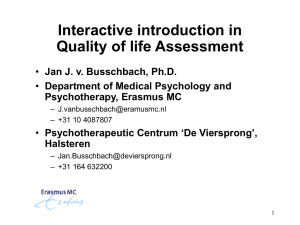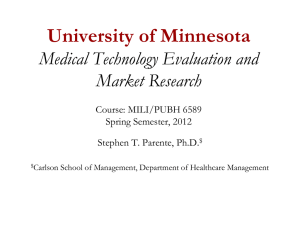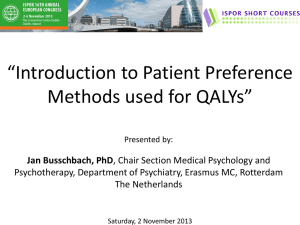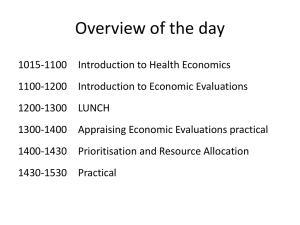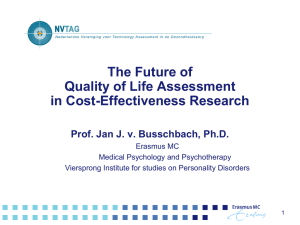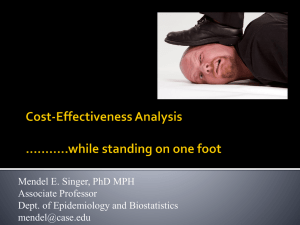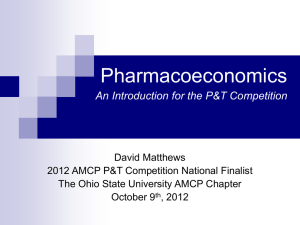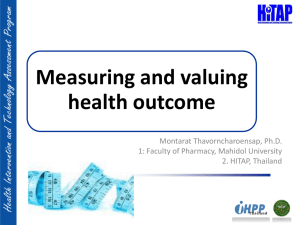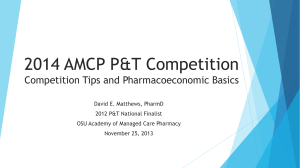The QALY debate
advertisement
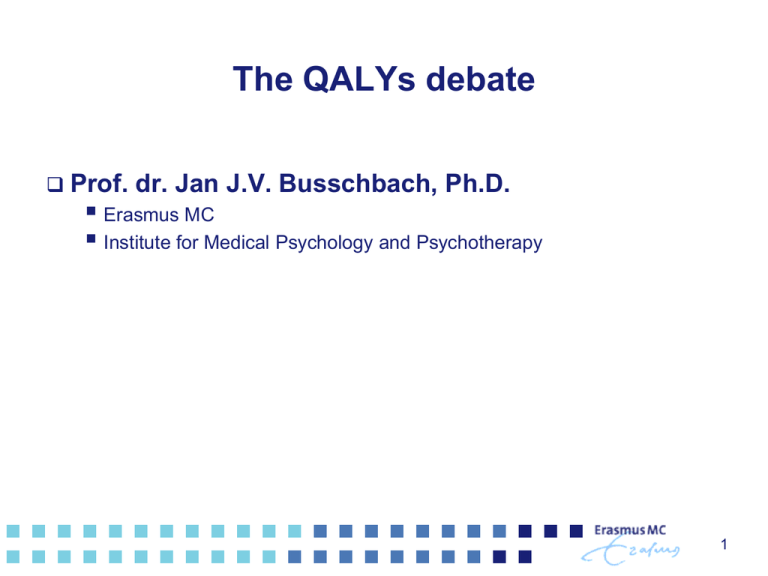
The QALYs debate Prof. dr. Jan J.V. Busschbach, Ph.D. Erasmus MC Institute for Medical Psychology and Psychotherapy 1 Health Economics Comparing different allocations Should we spent our money on • Wheel chairs • Screening for cancer Comparing costs Comparing outcome Outcomes must be comparable Make a generic outcome measure 2 Outcomes in health economics Specific outcome are incompatible Allow only for comparisons within the specific field • Clinical successes: successful operation, total cure • Clinical failures: “events” “Hart failure” versus “second psychosis” Generic outcome are compatible Allow for comparisons between fields • Life years • Quality of life Most generic outcome Quality adjusted life year (QALY) 3 Quality Adjusted Life Years (QALY) Example Blindness Time trade-off value is 0.5 Life span = 80 years 0.5 x 80 = 40 QALYs 1.00 X 0.5 x 80 = 40 QALYs 0.00 40 80 Life years 4 Time Trade-Off TTO Wheelchair With a life expectancy: 50 years How many years would you trade-off for a cure? Max. trade-off is 10 years QALY(wheel) = QALY(healthy) Y * V(wheel) = Y * V(healthy) 50 V(wheel) = 40 * 1 V(wheel) = .8 5 Standard Gamble SG Wheelchair Life expectancy is not important here How much are risk on death are you prepared to take for a cure? Max. risk is 20% wheels = (100%-20%) life on feet V(Wheels) = 80% or .8 6 1970 Area under the curve 1 QALY weights 0.9 0.8 0.7 0.6 Co-morbidity 0.5 Psychotherapy 0.4 No psychotherapy 0.3 0.2 0.1 0 0 10 20 30 40 50 60 70 80 Life years 8 Which health care program is the most cost-effective? A new wheelchair for elderly (iBOT) Special post natal care 9 www.ibotnow.com Dean Kamen Segway 10 Which health care program is the most cost-effective? A new wheelchair for elderly (iBOT) Increases quality of life = 0.1 10 years benefit Extra costs: $ 4,000 per life year QALY = Y x V(Q) = 10 x 0.1 = 1 QALY Costs are 10 x $4,000 = $30,000 Cost/QALY = 40,000/QALY Special post natal care Quality of life = 0.8 35 year Costs are $250,000 QALY = 35 x 0.8 = 28 QALY Cost/QALY = 8,929/QALY 11 QALY league table Intervention $ / QALY GM-CSF in elderly with leukemia 235,958 EPO in dialysis patients 139,623 Lung transplantation 100,957 End stage renal disease management 53,513 Heart transplantation 46,775 Didronel in osteoporosis 32,047 PTA with Stent 17,889 Breast cancer screening 5,147 Viagra 5,097 Treatment of congenital anorectal malformations 2,778 12 Milton Weinstein In the face of uncertainty … and fear The decision will be made, if not actively then by default 13 7000 Citations in PubMed Publications 1980[pdat] AND (QALY or QALYs) 1000 900 800 700 600 500 400 300 200 100 0 1975 1980 1985 1990 1995 2000 2005 2010 2015 14 QALY = Utility: Welfare theory QALY can be see as the ‘value of health’ The value of a good or service: “utility” Also called “nut” (Dutch) Welfare theory: maximize utility Maximize QALY Do we want to maximize QALY? Doubtful… 15 Is the utility scale valid? 1.0 0.0 A B C 16 Critique We do not maximize QALY But nevertheless we want to maximize utility • By (economic) definition.. That means: QALYs measured utility in an invalid way Life years is not the problem, thus… It must be the validity of quality of life assessment… 17 We don’t like the results… …it must be that QALYs are invalid In the past, much criticism Cohen CB. Quality of life and the analogy with the Nazis. Journal of Medicine and Philosophy 8: 113-35, 1983. Criticism remains ….the strictly fascist essence of those QALYs (so-called Quality-Adjusted Life Years)… 20 Burden as criteria 30 25 20 15 10 5 0 Accepted High burden Rejected Low burden Pronk & Bonsel, Eur J Health Econom 2004, 5: 274-277 21 Person Trade-Off Values between patients Not ‘within’ a patient like SG, TTO and VAS Better equipped for QALY? V(Q) = 1 - (A / B) For instance: V(Q) = 1 - (100/300) V(Q) = 1 - 0.33 V(Q) = 0.67 100 persons additionally 1 healthy year ?? persons 1 year free from disease Q 22 TTO does not correlate with PTO 1.0 TTO Utilities 0.8 PTO 0.6 0.4 0.2 0.0 Qu a dri ple Se gia ver Str Ch Dis Vi s ficu ron ea ion s l i c lo de t to dis ef mo t s pre r a ord we ee thm co ble de ssi n er r b r a t a a b r rol on ea ng (m te a c d s im kp ina ild t ca iab pa to a ete in nc irm mo er s en de t) rat ok e( Se Se ver es ver ea Dif e) 23 PTO and it’s psychometrics Paul Kind: If we look at TTO and PTO... we see that one of them is wrong If we look at PTO alone... We still see that one of them is wrong... 1,0 0,8 TTO PTO PTO 0,6 Utilities PTO is not a quick fix 0,4 0,2 0,0 24 Falsification even with life years A B C 25 Utility? 1.0 0.0 A B C 26 Utility Utility Total benefit Including distribution Also called “Nut” (Dutch) Quality of life might be part of total benefit QALYs do not include distribution But it is said that ‘Standard Gamble’ measures utilities! Van N-M utilities by definition utility But in SG only “health for your self” Does not include distribution 27 Costs/QALY as indicator of solidarity € 40.000 € 30.000 € 50.000 A B C 28 Costs/QALY versus Burden of disease X € 80.000 X € 60.000 X € 40.000 X € 20.000 € X 0 Burden of disease 29 Dutch Council for Public Health and Health Care (RvZ, 2006) 30 If a medical treatment costs >€80,000 to give one patient one extra life year of good quality, it should not be reimbursed in the basic health care insurance Council advises the Minister of Health to use this limit in order to keep the budget of health care under control; They realize the topic is controversial. Chris Murray WHO avoid QALY Havard Worked outside DALY Person Trade-Off School of Public Health Health economics Med Decision Making Reinvented 32 Burden of disease: QALY lost = DALY (Disability adjusted life year) DALY QALY 33 Burden of disease expressed as “QALY lost” = DALY Disability adjusted life years The inverse of QALY Used by the WHO Expresses burden of disease Measure of priority More burden, more investment QALY lost (DALY) = Measure of solidarity 34 QALY: both for effectiveness and solidarity Evaluations assess cost-effectiveness in term of cost/QALY But many decisions can not be explained by cost/QALY Explanation in terms of fairness People disagree with distributional implications of QALY maximisation Fairness is burden of disease Burden of disease is QALY lost (DALY) 35 QALY debate Fairness is the issue in the QALY debate QALY measurement is the straw man Complex metric discussion QALYs are needed to operationalize fairness Most debate about quality of life assessment Again as straw man But also within the metric debate of QALY 36 Reimbursement arguments Burden of disease Effects Cost effectiveness 37 Alternative applications Link to out of pocket payments Greater out of pocket payments for conditions with lower proportional shortfall E.g. France and Belgium For example: No reimbursement for the mildest conditions, such as common cold, acute tonsillitis, acute bronchitis, onychomycosis, tinea pedis Partial reimbursement for conditions mild to moderate conditions: Haemorrhoids, candidiasis, gastritis, osteoporosis, erectile dysfunction, acne conglobata Etc. 38 Take home message Quality of life assessment and health assessment is crucial Not only to estimate health gains (efficiency) But also to estimate need (equity) It is not the measurement of quality of life but the efficiency/equity trade-off which heats up the debate 39
